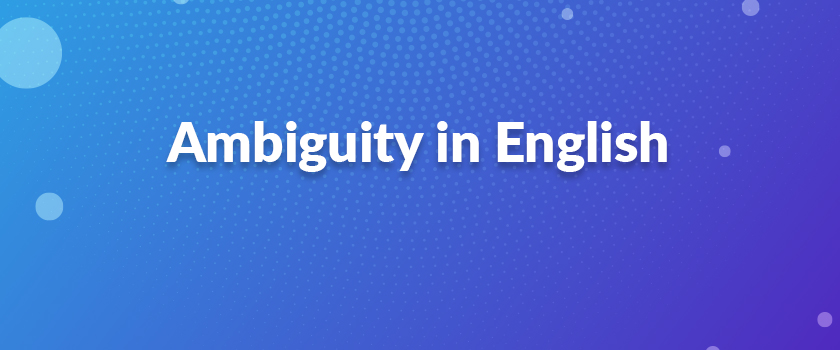Like any other languages, ambiguity is very common in English, too. The ambiguity can lie in words, phrases and sentences.
Ambiguity in words:
English teacher = a teacher who teaches English, whether he is an Englishman is unknown;
English teacher = a teacher from Britain, whether he teaches English is unknown.
Ambiguity in phrases:
Flying planes can be dangerous = The planes that is flying can be dangerous.
Flying planes can be dangerous = The action of flying planes can be dangerous.
Here is an old English joke:
A mother says to her little boy: “Johnny, go over the road and see how old Mrs Jones is”. The boy comes back and says to his mother: “Mrs Jones says it is none of my business”.
The mother meant “old” in a friendly way (“dear old Mrs Jones”), but the sentence could also mean: find out Mrs Jones’s age. This is obviously how Johnny understood his mother’s instruction.
While doing translation, it is very common that a sentence has two different meanings depending on what a specific sentence part modifies.
A simple example:
Complete the Lesson 1 activities in the Learning Journal.
Depending on the context, it can either be translated as “完成‘学习日志’中的第一课活动” (Here the “in the learning journal” part modifies the whole sentence as an adverbial modifies the whole sentence.),
or“在学习日志中完成第一课活动”(Here the “in the learning journal” part modifies the “lesson 1 activities” as an attribute.)
Another kind of ambiguity is like, in a complicated sentence with several phrases and one attributive clause, it is unclear whether the clause is modifying the last phrase or the whole series of phrases.
For example:
This course offers a journey to new sales account managers so that they can learn about their business vision and strategy, the market SWOT, and the competitive value that XX company offers to customers and distributors for selective growth.
Read Also: Try to Improve English Culture learning and awareness
The sentence can be translated as either:
本课程为新的销售客户经理提供了一个学习旅程,使他们了解业务愿景和战略、市场 SWOT,以及 XX 公司为客户和分销商提供的竞争力价值,从而取得选择性增长。
(The “XX company offers to customers and distributors” part only modifies “the competitive value”)
Or
本课程为新的销售客户经理提供了一个学习旅程,使他们了解 XX 公司为客户和分销商提供的业务愿景和战略、市场 SWOT,以及竞争力价值,从而取得选择性增长。
(The “XX company offers to customers and distributors” part modifies the whole “their business vision and strategy, the market SWOT, and the competitive value”)
We should try to avoid ambiguity when writing articles, but this phenomenon is very common and sometimes unavoidable when doing translation. The question is, how do you decide which one is the meaning that the author wants to express? Context and knowledge background are extremely important in those situations.
That is why some document of professional field should only be translated by translator with special knowledge. Learning the context, experience of translation is important to understand those sentences well, too.
Take a look at how we helped our client by localizing their project for English language. Click here to read the complete case study



